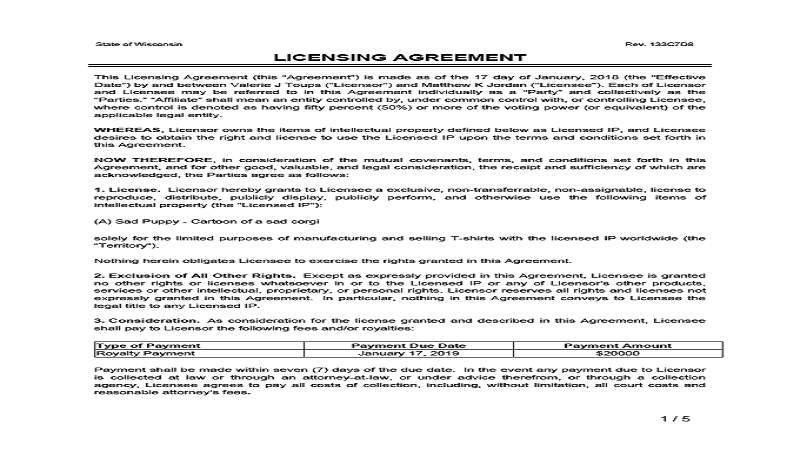Mangala Waman Karandikar (D) TR and LRS. vs. Prakash Damodar Ranade [Civil Appeal No. 10827 of 2010]
When a document is a straightforward proviso 6 of section
92 or section 95 of the Evidence Act do not apply.
Brief: In the instant case, the Supreme Court recognised several principles of contractual interpretation and set aside the reliance placed by the High Court on section 95 of the Evidence Act finding no ambiguity in the language of the agreement between the parties.
RELEVANT PARAGRAPH
9. Having heard both the parties at some length, at
the outset before we analyse this case,
we need to
observe some principles
on contractual interpretation. Unlike a statutory interpretation, which is
even more difficult due to assimilation of individual intention of law makers,
contractual interpretation depends on the intentions expressed by the parties
and dredging out the true meaning is an ‘iterative process’ for the Courts. In
any case, the first tool for interpreting, whether it be a law or contract is
to read the same.
10. It is usual that businessmen often do not sit
over nittygritty in a contract. In a document the language used by the parties
may have more than one meaning. It is ultimately the responsibility of the Courts
to decipher the meaning of the words used in a contract, having regards to a
meaning reasonable in the line of trade as understood by parties.
It may not be out of context to state that the development of rules of
contractual interpretation has been gradual and has
taken place over
century. Without going into
extensive study of precedents, in short, we may only state that the path
and development of law of interpretation has been a progress from a stiff formulism
to a strict rationalism.
11. It is
clear from the reading of the contract that the parties had intended to
transfer business from appellant to respondent during the contractual period.
This agreement was not meant as a lease or license for
the respondent to
conduct business. However, the respondent
contends that the meaning of the document should not be culled solely
with reference to
the language used
in the document, rather extrinsic evidence
needs to be
utilized before adducing proper
meaning to the contract. In this regard he submits that on
consideration of all
the extrinsic evidence, the contract should be read as a leave and
license agreement, which is covered under the Bombay Rent Act. He draws his
support from Section 95 of the Indian evidence Act to state that the document
needs to be interpreted having regard to external evidence such as receipts of payment
under the contract addressed as rent receipts etc.
14. It is manifest from these two sections that it is
only in cases where the terms of the document leave the question in doubt, then
resort could be had
to the proviso. But when a
document is a straightforward one and presents no
difficulty in construing it, the proviso does not apply. In this regard, we may
state that Section 95 only builds on the proviso 6 of Section 92.
15. If the contrary view is adopted as correct it
would render Section 92 of the Evidence Act, otiose and also enlarge the ambit
of proviso 6 beyond the main Section itself. Such interpretation, provided by
the High Court violates basic tenants of legal interpretation. Section 92 specifically
prohibits evidence of any oral agreement or statement which would contradict,
vary, add to or subtract from its terms. If, as stated by the learned Judge,
oral evidence could be received to show that the terms of the document were
really different from those expressed therein, it would amount to according
permission to give evidence to contradict or vary those terms and as such it comes within
the inhibitions of Section
92. It could
not be postulated that
the legislature intended to
nullify the object
of Section 92 by enacting exceptions to that section.
16. In line with the law laid down, it is clear that
the contract mandated continuation of the business in the name of ‘Karandikar
Brothers’ by paying royalties of Rs. 90 per month. Once the parties have accepted
the recitals and the contract, the respondent could not have adduced
contrary extrinsic parole
evidence, unless he portrayed ambiguity in the language. It may not be
out of context to note that the extension of the contract was on same
conditions.
17. On consideration
of the matter, the
High Court erred
in appreciating the ambit of Section 95, which led to consideration of evidence
which only indicates breach rather than ambiguity in the language of contract.
The evidence also points that the license was created for
continuation of existing
business, rather than license/lease
of shop premises. If the meaning provided by the High Court is accepted, then
it would amount to Courts substituting the bargain by the parties. The counsel
for respondent has emphasized much on the receipt of payment, which mentions
the term ‘rent received’. However, in line with the clear unambiguous language
of the contract, such evidence cannot be considered in the eyes of law.
